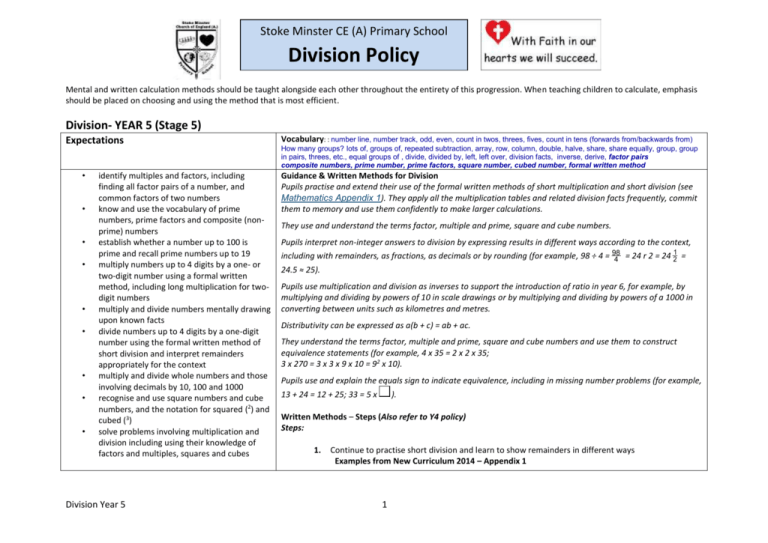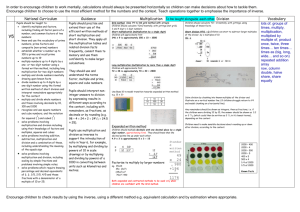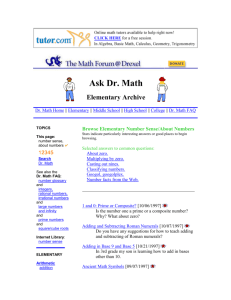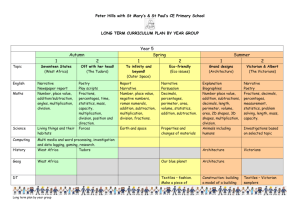Y5 Division CP - Stoke Minster CE School
advertisement

Stoke Minster CE (A) Primary School Division Policy Mental and written calculation methods should be taught alongside each other throughout the entirety of this progression. When teaching children to calculate, emphasis should be placed on choosing and using the method that is most efficient. Division- YEAR 5 (Stage 5) Expectations • • • • • • • • • identify multiples and factors, including finding all factor pairs of a number, and common factors of two numbers know and use the vocabulary of prime numbers, prime factors and composite (nonprime) numbers establish whether a number up to 100 is prime and recall prime numbers up to 19 multiply numbers up to 4 digits by a one- or two-digit number using a formal written method, including long multiplication for twodigit numbers multiply and divide numbers mentally drawing upon known facts divide numbers up to 4 digits by a one-digit number using the formal written method of short division and interpret remainders appropriately for the context multiply and divide whole numbers and those involving decimals by 10, 100 and 1000 recognise and use square numbers and cube numbers, and the notation for squared (2) and cubed (3) solve problems involving multiplication and division including using their knowledge of factors and multiples, squares and cubes Division Year 5 Vocabulary: : number line, number track, odd, even, count in twos, threes, fives, count in tens (forwards from/backwards from) How many groups? lots of, groups of, repeated subtraction, array, row, column, double, halve, share, share equally, group, group in pairs, threes, etc., equal groups of , divide, divided by, left, left over, division facts, inverse, derive, factor pairs composite numbers, prime number, prime factors, square number, cubed number, formal written method Guidance & Written Methods for Division Pupils practise and extend their use of the formal written methods of short multiplication and short division (see Mathematics Appendix 1). They apply all the multiplication tables and related division facts frequently, commit them to memory and use them confidently to make larger calculations. They use and understand the terms factor, multiple and prime, square and cube numbers. Pupils interpret non-integer answers to division by expressing results in different ways according to the context, 1 including with remainders, as fractions, as decimals or by rounding (for example, 98 ÷ 4 = 98 4 = 24 r 2 = 24 2 = 24.5 ≈ 25). Pupils use multiplication and division as inverses to support the introduction of ratio in year 6, for example, by multiplying and dividing by powers of 10 in scale drawings or by multiplying and dividing by powers of a 1000 in converting between units such as kilometres and metres. Distributivity can be expressed as a(b + c) = ab + ac. They understand the terms factor, multiple and prime, square and cube numbers and use them to construct equivalence statements (for example, 4 x 35 = 2 x 2 x 35; 3 x 270 = 3 x 3 x 9 x 10 = 92 x 10). Pupils use and explain the equals sign to indicate equivalence, including in missing number problems (for example, 13 + 24 = 12 + 25; 33 = 5 x ). Written Methods – Steps (Also refer to Y4 policy) Steps: 1. Continue to practise short division and learn to show remainders in different ways Examples from New Curriculum 2014 – Appendix 1 1 • • solve problems involving addition, subtraction, multiplication and division and a combination of these, including understanding the meaning of the equals sign solve problems involving multiplication and division, including scaling by simple fractions and problems involving simple rates. 4 4 2. Introduce division by a two-digit number using extended long division, showing remainder as fractions, decimals or rounding. Examples from New Curriculum 2014 – Appendix 1 3. When pupils have a thorough understanding they can use compact long division. becomes 4. Division Year 5 Divide a 4 digit number by a 2 digit number 2 0 6 r 16 23 4 7 5 4 46 154 138 16 2 As 16 is more than half of 23,this rounds up to approximately 278 Division Year 5 3









